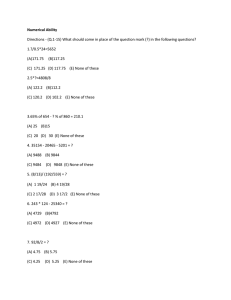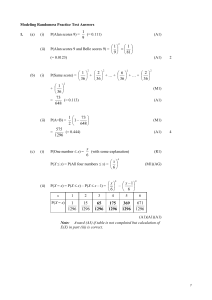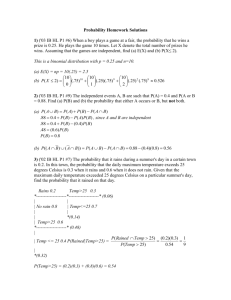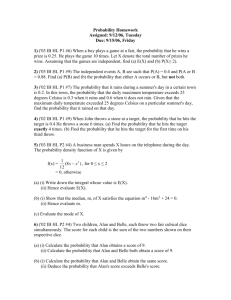Math 5010 § 1. Solutions to Sixth Homework Treibergs February 27, 2009
advertisement
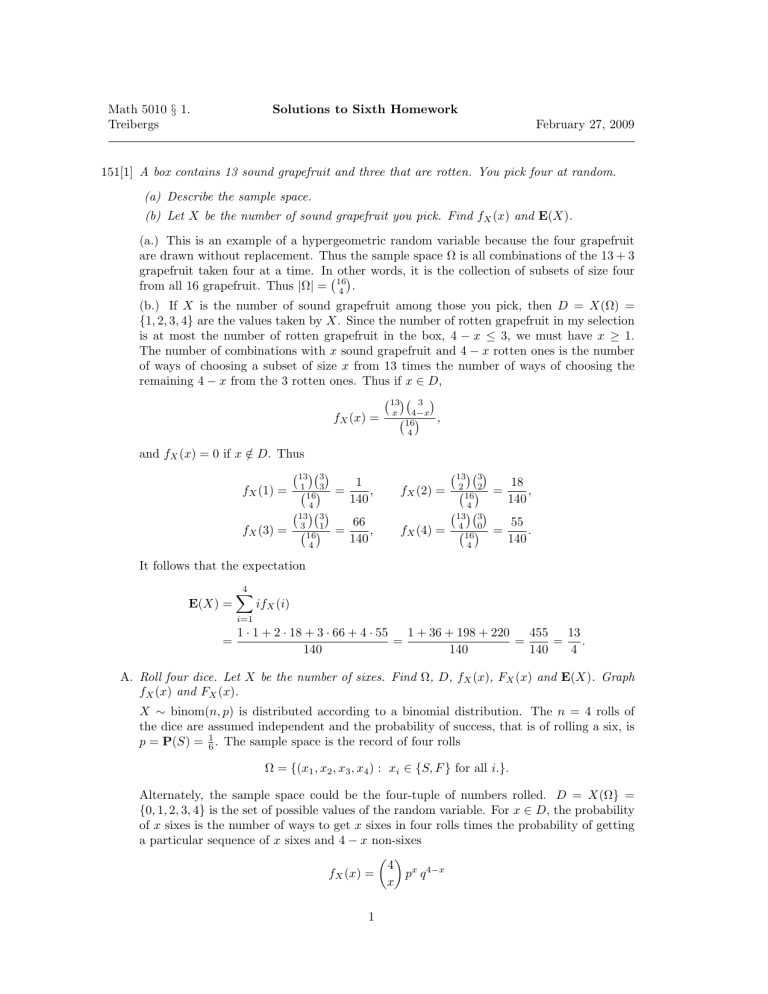
Math 5010 § 1.
Treibergs
Solutions to Sixth Homework
February 27, 2009
151[1] A box contains 13 sound grapefruit and three that are rotten. You pick four at random.
(a) Describe the sample space.
(b) Let X be the number of sound grapefruit you pick. Find fX (x) and E(X).
(a.) This is an example of a hypergeometric random variable because the four grapefruit
are drawn without replacement. Thus the sample space Ω is all combinations of the 13 + 3
grapefruit taken four at a time. In other
words, it is the collection of subsets of size four
from all 16 grapefruit. Thus |Ω| = 16
4 .
(b.) If X is the number of sound grapefruit among those you pick, then D = X(Ω) =
{1, 2, 3, 4} are the values taken by X. Since the number of rotten grapefruit in my selection
is at most the number of rotten grapefruit in the box, 4 − x ≤ 3, we must have x ≥ 1.
The number of combinations with x sound grapefruit and 4 − x rotten ones is the number
of ways of choosing a subset of size x from 13 times the number of ways of choosing the
remaining 4 − x from the 3 rotten ones. Thus if x ∈ D,
3 13
fX (x) =
x
4−x
16
4
,
and fX (x) = 0 if x ∈
/ D. Thus
13 3
1
3
16
4 13 3
3
1
16
4
fX (1) =
fX (3) =
fX (2) =
66
,
140
fX (4) =
=
13 3
2
2
16
4 13 3
4
0
16
4
1
=
,
140
=
18
,
140
=
55
.
140
It follows that the expectation
E(X) =
4
X
ifX (i)
i=1
=
1 · 1 + 2 · 18 + 3 · 66 + 4 · 55
1 + 36 + 198 + 220
455
13
=
=
=
.
140
140
140
4
A. Roll four dice. Let X be the number of sixes. Find Ω, D, fX (x), FX (x) and E(X). Graph
fX (x) and FX (x).
X ∼ binom(n, p) is distributed according to a binomial distribution. The n = 4 rolls of
the dice are assumed independent and the probability of success, that is of rolling a six, is
p = P(S) = 16 . The sample space is the record of four rolls
Ω = {(x1 , x2 , x3 , x4 ) : xi ∈ {S, F } for all i.}.
Alternately, the sample space could be the four-tuple of numbers rolled. D = X(Ω} =
{0, 1, 2, 3, 4} is the set of possible values of the random variable. For x ∈ D, the probability
of x sixes is the number of ways to get x sixes in four rolls times the probability of getting
a particular sequence of x sixes and 4 − x non-sixes
4 x 4−x
fX (x) =
p q
x
1
x
0
fX (x)
4
0
1 0
6
5 4
6
=
FX (x)
54
64
=
625
1296
625
1296
1
4
1
1 1
6
5 3
6
=
4·53
64
=
500
1296
625+500
1296
2
4
2
1 2
6
5 2
6
=
6·52
64
=
150
1296
625+500+150
1296
3
4
3
1 3
6
5 1
6
=
4·5
64
=
20
1296
625+500+150+20
1296
=
1295
1296
4
4
4
1 4
6
5 0
6
=
1
64
=
1
1296
625+500+150+20+1
1296
=1
=
1125
1296
=
1275
1296
Figure 1: Table of p.d.f and c.d.f for x ∈ D.
and fX (x) = 0 if x ∈
/ D. Values are given in Figure 1. The cumulative distribution function
for x ∈ D is given by
FX (x) =
X
j ∈ D and j ≤ x
fX (j) =
x
X
fX (j).
j=0
Note that for any real x, FX (x) = 0 if x < 0, FX (x) = FX (bxc) if 0 ≤ x ≤ 4 and FX (x) = 1
if x > 4. (bxc is the greatest integer function of x.) The expectation is
E(X) =
4
X
ifX (i)
i=0
=
500 + 300 + 60 + 4
864
2
0 · 625 + 1 · 500 + 2 · 150 + 3 · 20 + 4 · 1
=
=
= .
1296
1296
1296
3
Graphing gives
Figure 2: Graphs of fX (x) and FX (x).
2
B. let D = {1, 2, 3, . . . , n}. Let f (x) = cx for x ∈ D and f (x) = 0 for x ∈
/ D. Find c to make
f (x) a p.d.f. Find FX (x) and E(X).
To be a probability density function, we need f (x) ≥ 0 so c > 0 must hold. Also the total
probability satisfies
n
X
X
cn(n + 1)
1=
f (x) =
,
ci =
2
i=1
x∈D
using the formula for the sum of the first n numbers. Hence
c=
2
.
n(n + 1)
Using the same formula we get the cumulative distribution function. For x ∈ D,
X
FX (x) =
f (j) =
j ∈ D and j ≤ x
x
X
j=1
cj =
x(x + 1)
.
n(n + 1)
Thus for any real x, FX (x) = 0 if x < 1, FX (x) = 1 if x ≥ n and FX (x) = FX (bxc) if
1 ≤ x ≤ n, where bxc denotes the greatest integer function.
Using the formula for the sum of the first n squares, the expectation is
E(X) =
X
x∈D
x f (x) =
n
X
i=1
c i2 =
n(n + 1)(2n + 1)
2n + 1
2
·
=
.
n(n + 1)
6
3
3
